This publication is part of a series developed to assist Florida homeowners with managing their landscapes to reduce environmental impacts. This is a joint publication of multiple departments and programs in UF/IFAS, including the Florida-Friendly Landscaping™ program, the Department of Soil and Water Science, the Environmental Horticulture Department, and the Center for Landscape Conservation and Ecology. This fact sheet was produced with support from the Florida Turfgrass Association through a Florida Department of Agriculture and Consumer Services Specialty Crops Block Grant.
For the rest of this series, visit https://edis.ifas.ufl.edu/topic_series_environmental_landscape_management.
Introduction
Soil is the most important building block of a healthy, attractive landscape, serving many essential physical, chemical, and biological functions. Soil provides a physical substrate for plant support and holds nutrients and water for plant use. It also facilitates groundwater recharge (water moving from surface water to groundwater) and provides long-term storage for organic matter. Soil also provides a habitat for microorganisms that aid in the transformation and availability of nutrients. Soil is an integral part of any ecosystem, but urbanization often changes soils in ways that negatively affect plant development. Soils in urban areas may have reduced water infiltration, resulting in increased runoff and increased potential for nutrient losses. Homeowners in urban areas often overcompensate for poor planting conditions by applying excessive amounts of fertilizer and water. These practices eventually lead to nutrient losses through stormwater runoff or soil leaching, and these lost nutrients negatively impact groundwater and ecosystems in nearby springs, streams, and water bodies.
Ideal soil conditions for planting a new landscape include the following:
- Loamy texture (i.e., a mixture of sand, silt, and clay) for holding nutrients and water
- Well-drained to avoid standing water around plants and to provide groundwater recharge
- Slightly acidic to neutral pH
- Adequate organic matter to hold water between rain and irrigation events and to provide nutrients for plants
- Little to no compaction so that roots can easily penetrate the soil and oxygen and water can reach the roots
- Low soluble salt content
These conditions are rarely present in home landscape soil, especially soon after constructing a new home. During construction, home sites undergo numerous changes that disrupt the soil and do not leave landscape soil in an ideal condition for planting.
What are the challenges associated with urban soils?
Before your neighborhood was developed, the soil was most likely naturally formed, consisting of air, water, microorganisms, organic matter, some nutrients, and minerals. The soil may have been part of a natural, forested ecosystem or agricultural soil. Common construction and development practices changed these natural soils to a more challenging environment for growing plants when your home was built.
Characteristics of Urban Soils
The disturbance of soils after construction occurs in many ways—there is no such thing as a typical post-construction urban soil. However, urban soils share several common characteristics responsible for the challenges in establishing and maintaining landscape plants and turfgrass:
- Variable soil characteristics and texture
- Compacted soil conditions
- Poor soil structure and low organic matter content
- High variability in fertility and pH levels
- Low biological activity
Variable Soil Characteristics and Texture
Often, fill material (sand) from nearby areas is brought to the construction site. This sand is spread over the native soil, burying the topsoil layer (Figure 1). The fill sand serves as the base for placing the concrete slab for the home foundation. The fill material is also spread around the site on areas that will become the lawn and landscape. The fill sand has low organic matter and nitrogen content. It also can have a wide range of phosphorus and other nutrient contents and typically has a low water-holding capacity. Additional sand or topsoil may be imported and added over the sandy fill material during the final site development process. Moving the soil and mixing the soil profile create highly variable physical and chemical characteristics (Figure 2) and can result in considerable compaction in urban soils.

Credit: George Hochmuth
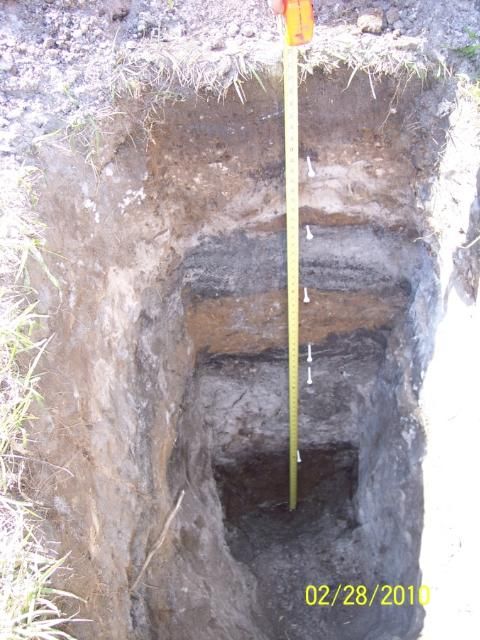
Credit: Don Rainey
In some locations of Florida, dredged material from stormwater retention ponds is applied on site. This material may have a high clay content, which leads to challenges in establishing new landscapes. Clay soils do not drain well and can be easily compacted (Figure 3). Soils with high amounts of clay can lead to poor root development (Figure 4) and are susceptible to standing water during much of the year. This leads to waterlogging of the soil and root rot. During the final grading process and landscape bed preparation, a thin layer of topsoil is commonly applied on top of the fill material to aid in plant establishment, but the underlying soil problems remain.
Finally, the soil at the home site may contain other construction debris such as wire, wood, nails, asphalt paper, and concrete shards. These materials can also restrict plant root development for newly established landscape plants. Drywall and masonry debris can change the soil's chemical properties, for example, pH and other beneficial nutrient-holding capacities. This will be discussed in greater detail later.
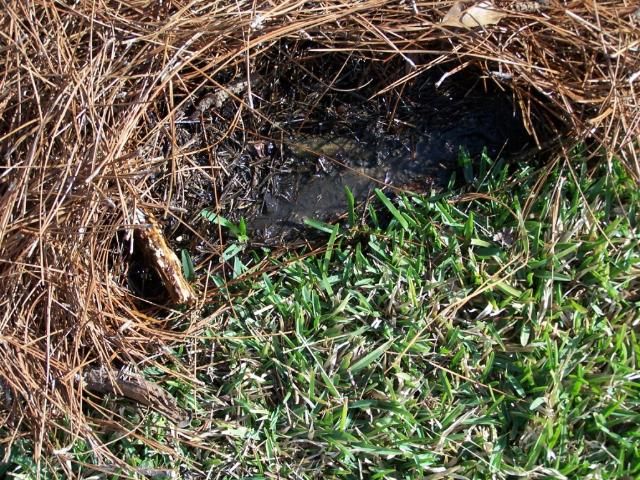
Credit: Don Rainey
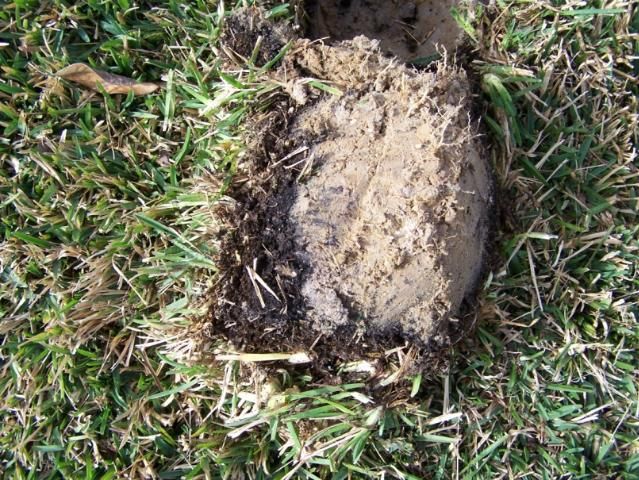
Credit: Don Rainey
Soil Compaction
The construction of a residential home involves human and mechanical traffic, often resulting in soil compaction (Figure 5). Compaction of urban soils reduces air availability to plant roots and decreases the amount of rainwater that can percolate into the soil. The water running off these landscapes can carry soil and nutrients from the site and possibly deposit them in local waterways. Compacted soils can be especially problematic in sloped home sites, leading to more increased stormwater runoff and soil erosion.
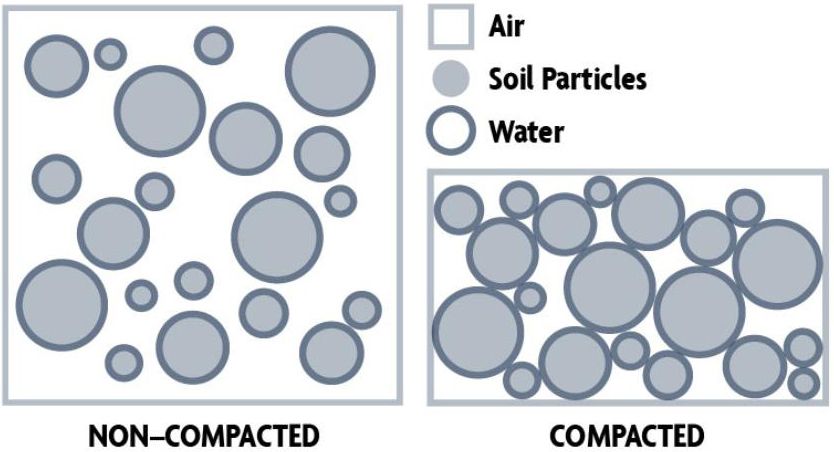
Credit: UF/IFAS Communications
Soil Organic Matter Content
Amending the final grade with additional organic matter improves soil structure by increasing soil aggregation (the ability of the soil to form clumps) and improving soil aeration and water-holding capacity. Organic matter in high-quality soil is a major source of plant nutrients such as nitrogen and phosphorus. Organic matter is also the food source for many beneficial soil microbes such as bacteria and fungi that help regulate nutrient availability in the soil. It also supports other animals, such as earthworms that help aerate the soil. Native soil often contains organic matter, but this layer is often buried under several feet of fill sand that has little or no organic matter content during construction and development. The low soil organic matter content in urban soils may lead homeowners to apply higher levels of fertilizer and water to compensate for the lost organic matter. This leads to increased water use and the potential for nutrient leaching or runoff. For more information on amending the soil in the urban landscape, see https://edis.ifas.ufl.edu/publication/AE566 and https://edis.ifas.ufl.edu/pdf/LH/LH01200.pdf
Variability in Soil Nutrient Content and pH Level
Urban soils often contain considerable debris left behind from construction. For example, concrete waste can directly impact the pH level in landscape soil. Soil pH is generally elevated near masonry walls and foundations due to the lime and concrete residues from construction. Concrete debris may also be buried in other landscape areas, resulting in pockets of soil where elevated pH makes it difficult to establish landscape plants that need an acidic pH. Plants growing in these high pH soils may exhibit micronutrient deficiency symptoms, such as yellowing of upper leaves, similar to an iron deficiency. In addition to the concrete waste, irrigation water typically has high pH levels, which gradually increases landscape the soil pH over time. Depending on the fill material source, there can also be a dramatic difference in the pH and nutrient availability of native soils and fill material (Figure 6).
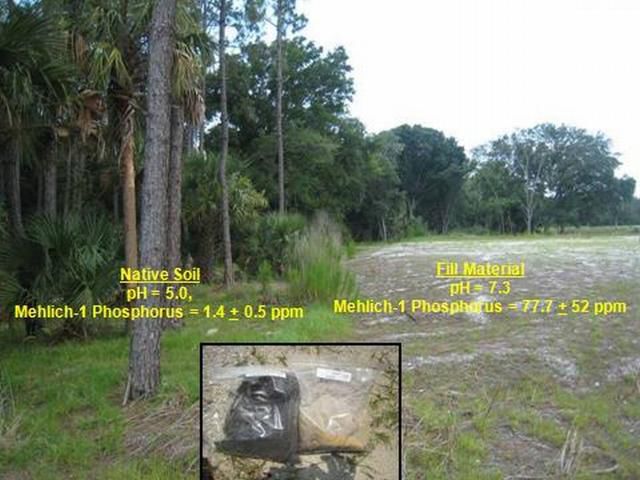
Credit: M. Clark
Soils with Low Biological Activity
Healthy soils are critical to building a strong ecosystem and supporting wildlife in the landscape (Figure 7). Soils in most new construction sites contain low populations of soil microorganisms. Healthy soil contains a rich mixture of the plant (flora) and animal life (fauna). These organisms help decompose organic matter, cycle nutrients in the soil and retain nutrients for plant uptake. An active soil ecosystem can help reduce the amount of fertilizers required in the landscape. As organic matter and plant materials decompose, they provide food for nematodes, fungi, and bacteria that form the food web base.
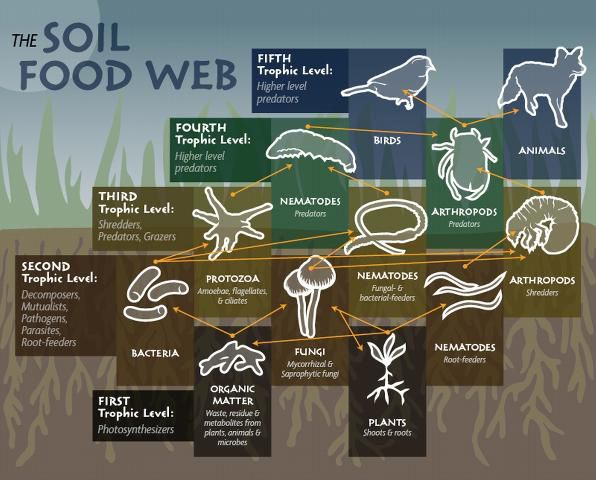
Credit: UF/IFAS Communications
Ways to Improve Urban Soils and Make Your Landscape Environmentally Friendly
Managing a landscape planted in disturbed urban soils can be challenging. The homeowner should recognize that these soils may create opportunities for pollution from lawn and landscape fertilization. Ideally, a new home buyer can control the landscape soil development before landscape plants are selected and installed. If confronted with poor urban soils, the homeowner has options to improve the health of the landscape plants and reduce the environmental impacts of landscape management. Soil compaction, high pH levels, and lack of organic matter are major factors in urban soil that lead to water and nutrient management challenges. The homeowner may have an impact on these soil characteristics.
Soil Compaction
The first step a homeowner should take is to assess the soil for compaction. Detailed soil tests can be done to make this determination. These tests include measuring soil bulk density and penetration resistance with a penetrometer. These tests are not always readily available, so the homeowner is advised to check with the local UF/IFAS Extension office (https://sfyl.ifas.ufl.edu/find-your-local-office/) about the availability of soil compaction tests or for names of available services. Alternatively, the homeowner can observe the landscape for standing water or conduct a simple soil compaction test with a shovel or soil probe. Compacted soil makes it difficult to push a shovel, hollow tube, or metal rod into the ground more than a few inches.
Soil Test to Determine Soil Nutrient Content and pH Level
Next, a soil sample should be taken from several areas in the landscape and analyzed separately to determine soil nutrient levels and soil pH. Your local county UF/IFAS Extension office has more information about testing the soil in your landscape. The soil test results can guide you to proper decisions about pH management and fertilizer needs of plants to be installed. Also, during soil sampling, you can observe any areas of compacted soil. Please refer to Soil Testing and Sampling for the Home Landscape or Vegetable Garden by Amy L. Shober and Rao S. Mylavarapu at https://edis.ifas.ufl.edu/ss494. More information and guidelines on the physical and chemical assessment of the soil at the site is presented by Shober, Weise, Toor, and Reisinger (2019) (https://edis.ifas.ufl.edu/ss534).
Modifying the soil pH, especially high soil pH, is challenging. This is especially difficult when we irrigate with basic (high pH) well or municipal water. Landscaping with plants tolerant of high soil pH conditions is a good approach. Chemically reducing soil pH with sulfur additions may help, and using "acid-forming" ammonium sulfate or urea-based nitrogen fertilizers is beneficial, but usually, the effect is temporary. Relying on rainfall or harvested rainwater as much as possible also helps to minimize additions of high-pH irrigation water. Amend the soil with a quality organic matter, such as certified compost when replacing plants in the landscape. Shober, Wiese, Denny, and Mylavarapu (2019) provide guidelines for reducing the soil pH in the landscape. These approaches help to improve plant growth, increase the efficiency of fertilizer and water use in the landscape, and reduce the likelihood of nutrient losses from the landscape.
Poor Soil Structure and Low Organic Matter
The ideal organic matter composition in the soil consists of currently living and recently living organisms and fresh, decomposing, and stabilized (fully decomposed) organic matter (Figure 8). As the organic matter degrades, it increases the soil's nutrient- and water-holding capacities. The process of mixing organic matter into the soil breaks up compacted soil areas. Organic matter improves soil structure, reduces compaction, and helps moderate soil pH increases.

Credit: UF/IFAS Communications
The best course of action for soil improvement is to build organic matter in the landscape over time to achieve the desired proportions of the various organic matter components. Depending on where it is, organic matter can be applied by several methods.
For established plant beds, the easiest method is to use compost made from grass clippings and other organic materials. Turfgrass clippings should be put on the lawn where they can decompose and return organic matter and nutrients. Compost can be applied as mulch or topdressing to landscape beds. Use fully composted materials for incorporation into the soil. As a rule of thumb, compost should not have any recognizable pieces of organic matter (e.g., sticks, leaves, wood chips, etc.).
Compost can be mixed into the root zone before planting to prepare a new plant bed. This mixing can be done with a shovel; use a rototiller for larger areas. However, a tiller should not be used in areas containing established trees or woody shrubs. The root systems of these plants extend well outside the canopy, and a tiller can cause severe root damage. Use the free service "Dial 811" to determine where electrical and data/phone wires are located.
Increasing soil organic matter has positive effects on nutrient and water management in the landscape. Organic matter helps hold water and nutrients in the soil, likely reducing the amounts of fertilizer and irrigation required. Improving soil quality with organic matter reduces the potential for nutrient losses from the landscape, making your home site more environmentally friendly. Issues, such as compaction and lack of microbial biological activity, will be resolved as improvements are made and the landscape evolves.
When improving soil quality, patience is important, because conditions may take years to improve.
Plant Selection
Choosing the right plant for the right place in your landscape is an integral part of creating a Florida-Friendly landscape. Sometimes there is little you can do to change the soil in the landscape. Selecting plants that tolerate or thrive in poor soil conditions may be the most effective and least expensive approach. To learn which plants can tolerate high soil pH conditions, see The Florida-Friendly Landscaping™ Guide to Plant Selection & Landscape Design at https://ffl.ifas.ufl.edu/.
Summary
Soil is the basic building block of any landscape; however, inappropriate home construction practices can result in challenging management issues for soils in the home landscape.
Disturbed urban soils can result in poor plant growth, increased water and fertilizer requirements, and increased susceptibility to pests and disease. Elevated pH levels and high soil compaction can lead to serious water quality issues if homeowners do not take the proper steps to improve soil quality. The best course of action for homeowners is to start with a soil assessment and soil tests and then to build organic matter in the landscape over time. The addition of organic matter content increases nutrient- and water-holding capacities and makes the soil easier to till for planting. Correcting soil quality problems in the landscape development stage results in a more Florida-Friendly landscape with reduced water pollution and nutrient loss.
References
Florida-Friendly Landscaping Program. Gainesville: University of Florida Institute of Food and Agricultural Sciences. https://ffl.ifas.ufl.edu/
Ingham, E. R. 2000. "The Soil Food Web." In Soil Biology Primer, edited by A. J. Tugel, A. M. Lewandowski, and D. Happe-vonArb. Iowa: Soil and Water Conservation Society. https://www.swcs.org/resources/publications/soil-biology-primer
Shober, A. L., C. Wiese, and G. S. Toor, and A. Reisinger. 2019. Preplant Soil Assessment for New Residential Landscapes in Florida. Gainesville: University of Florida Institute of Food and Agricultural Sciences. https://edis.ifas.ufl.edu/ss534
Shober, A. L., C. Wiese, and G. C. Denny, and R. Mylavarapu. 2019. Soil pH and the Home Landscape or Garden. Gainesville: University of Florida Institute of Food and Agricultural Sciences. https://edis.ifas.ufl.edu/ss480
Shober, A. L., and R. S. Mylavarapu. 2018. Soil Testing and Sampling for the Home Landscape or Vegetable Garden. Gainesville: University of Florida Institute of Food and Agricultural Sciences. https://edis.ifas.ufl.edu/ss494
U.S. Environmental Protection Agency. 2021. Evaluation of Urban Soils: Suitability for Green Infrastructure or Urban Agriculture. EPA publication no. 905R1103. https://www.epa.gov/green-infrastructure